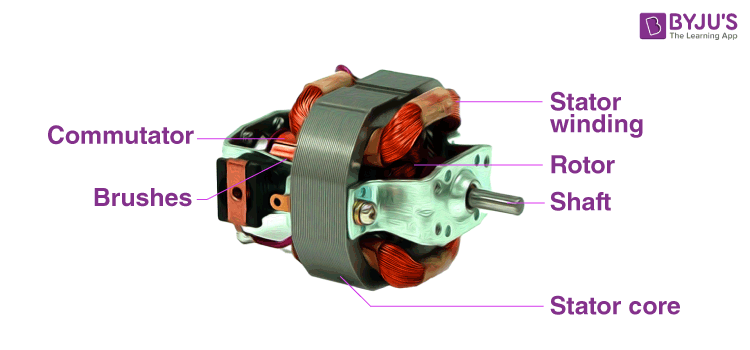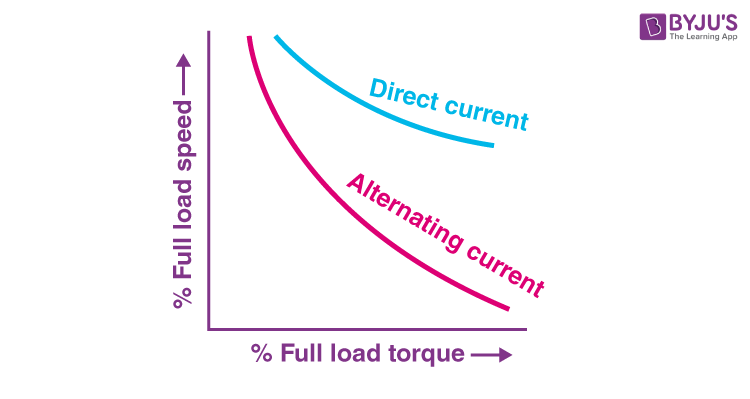| Table of Contents |
What Is a Universal Motor?
A universal motor is a special type of motor that runs on both AC and DC power supplies. Universal motors are series-wound (the armature and field windings are in series). The series connection allows them to generate high torque; hence the universal motors are generally built into the device they are meant to drive.
Most of the universal motors are meant to operate at speeds as high as 3500 RPM. These motors run at a higher speed on DC supply than they run on AC supply of the same voltage. This is due to the reactance voltage drop that is present only in AC and not in DC.
How does a Universal Motor run on both AC and DC supply?
The construction of a universal motor is similar to that of a series-wound DC motor. A universal motor incorporates some modification that allows it to operate either on AC or DC supply.
Construction of a Universal Motor

A universal motor consists of a stator on which the field poles are mounted. Field coils are wound around the field poles. Both the stator field circuit and armature of a universal motor are laminated. Laminations are necessary to reduce the eddy currents that are produced while operating on AC power.
The universal motor’s rotary armature is made of straight or skewed slots on which the commutator and brushes rest. The commutation on AC is poorer than that for DC because of the current induced in the armature coils. For this reason, the brushes used have high resistance.
Operation of Universal Motor
When fed with a DC supply
When the universal motor is fed with a DC supply, it works as a DC series motor. In this case, when the current flows in the field winding, it produces an electromagnetic field. The same current also flows in the armature conductors. When a current-carrying conductor is placed in a magnetic field, the conductor experiences a mechanical force. This mechanical force causes the rotor to rotate. Fleming’s Left-hand rule gives us the direction of this force.
When fed with an AC supply
A unidirectional torque is produced when the universal motor is supplied with AC power. This is because the armature winding and the field winding are connected in series and are in the same phase. Therefore, whenever the polarity of the AC changes, the direction of the current in the armature and the field winding changes simultaneously. The direction of the magnetic field and the direction of armature current reverse so that the direction of force experienced by armature conductors remains the same. Thus, regardless of AC or DC supply, universal motors work on the same principle that DC series motors work on.
|
Similar Reading |
Properties of Universal Motors
Following are the distinctive properties of the universal motor:
- They run at high speed.
- They have high starting torque.
- Compact size and are lightweight.
- They are noisy because of the commutator and brushes.
Characteristics of Universal Motors
Efficiency of Universal Motor
The efficiency of smaller universal motors is around 30%, while the larger universal motors have an efficiency of 70-75%.
Speed Load Characteristics of Universal Motor

The speed of the universal motor is the lowest at full load and the highest at no load. Gear trains are made use of to get the required speed at the required load. The speed-load characteristics of universal motors for both AC and DC are shown in the figure above.
Universal Motor Speed Control
The universal motor’s speed is controlled to avoid the motor running at a dangerous speed at no load. One method to control the speed is to build the universal motor into a device to never run on no-load condition. These setup types are preferred for small applications that favour connecting the motor directly to the system that it drives.
A few other ways to set the speed of the motor to the desired value is as follows:
- Using a gear train to reduce the actual load speed
- Resistance method of speed control
- Centrifugal Mechanism
- Field Tapping method of speed control
Applications of Universal Motor
Universal motors are used in applications where high speed and good speed control is necessary. Following are the various applications of universal motor:
- Universal Motors are used in table fans, hairdryers and grinders.
- They are used in portable drill machines.
- They are used in polishers, blowers and kitchen appliances.
Frequently Asked Questions – FAQs
What is a Universal Motor, and why is it called so?
Universal Motor is a special type of motor that can run on a DC supply or a single-phase AC supply. Since it can run both on AC and DC, it is called a universal motor.
Can a Universal Motor be used as a generator?
Yes, but a universal motor is a DC series motor that does not make a good generator with general purpose characteristics.
How does a Universal Motor work?
A universal motor works as a DC series motor when fed with a DC supply. A magnetic field is produced when the current flows through the field winding. The same current also flows through the armature conductors. We know that when a current-carrying conductor is placed in an electromagnetic field, it experiences a mechanical force. Due to this mechanical force, the rotor starts to rotate.
Where is a Universal Motor used?
Due to their high starting torque and compactness, universal motors are used in portable power tools and equipment.
List two differences between Universal Motor and DC series Motor.
- The universal motor has different winding ratios and thinner iron laminations.
- A universal motor can also operate on AC power, while a DC series motor operates only on DC power.
Stay tuned to BYJU’S and Fall in Love with Learning!
Comments